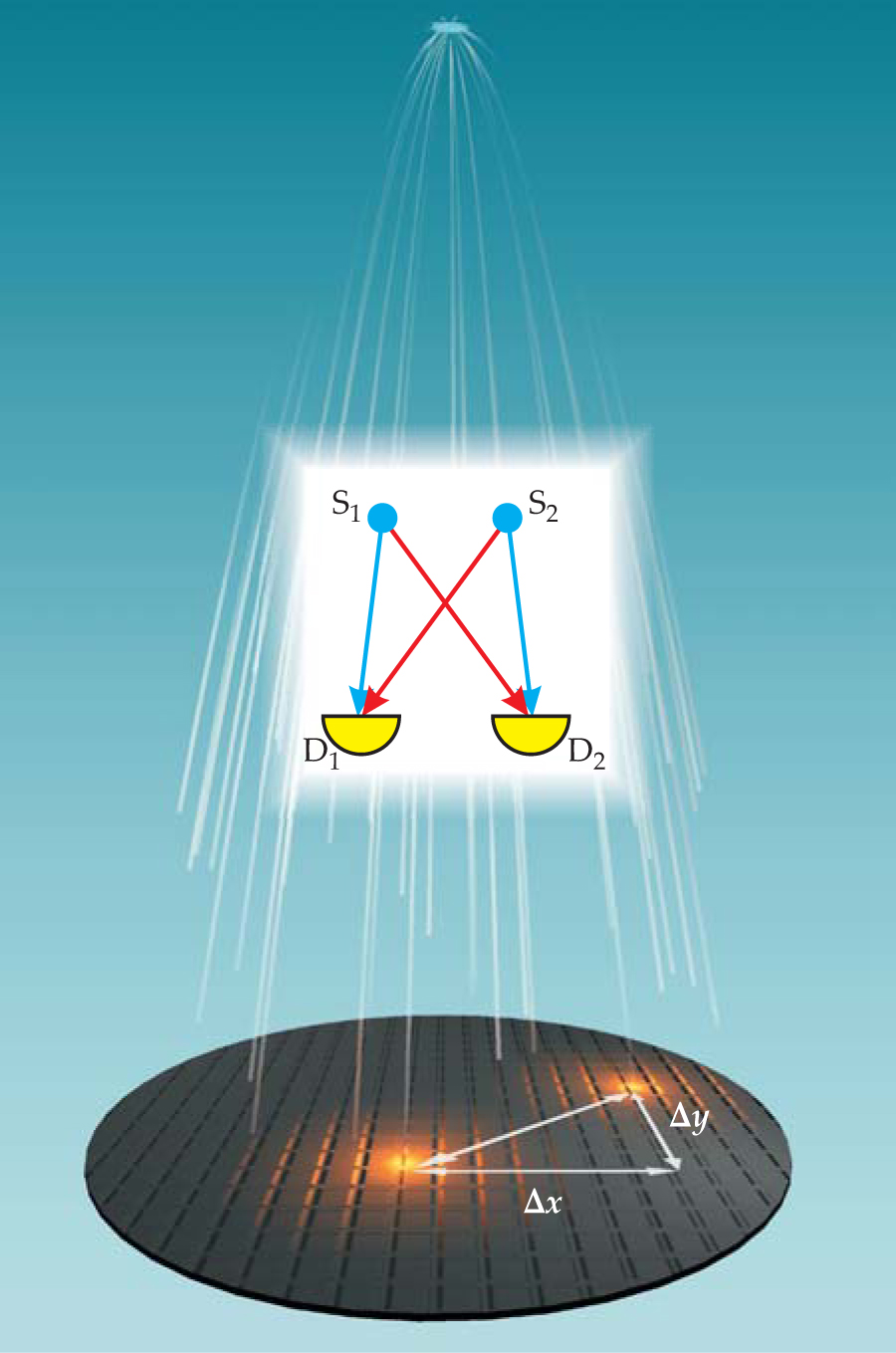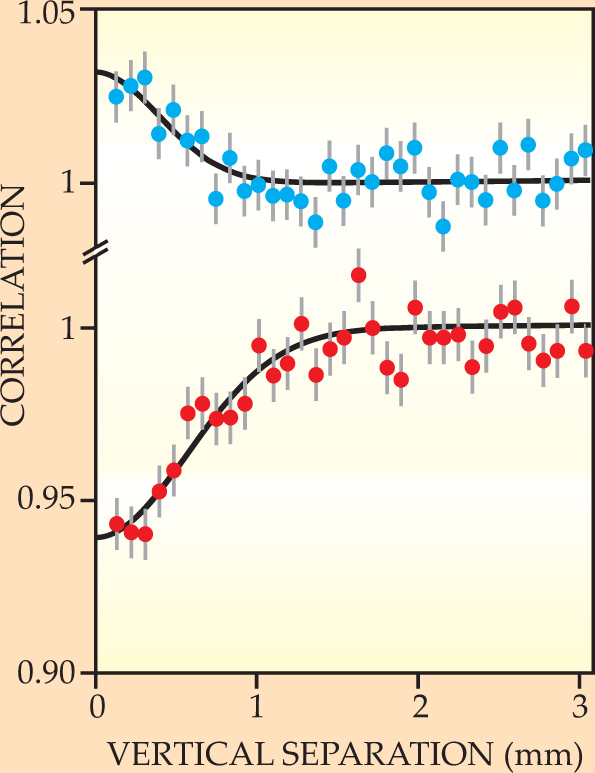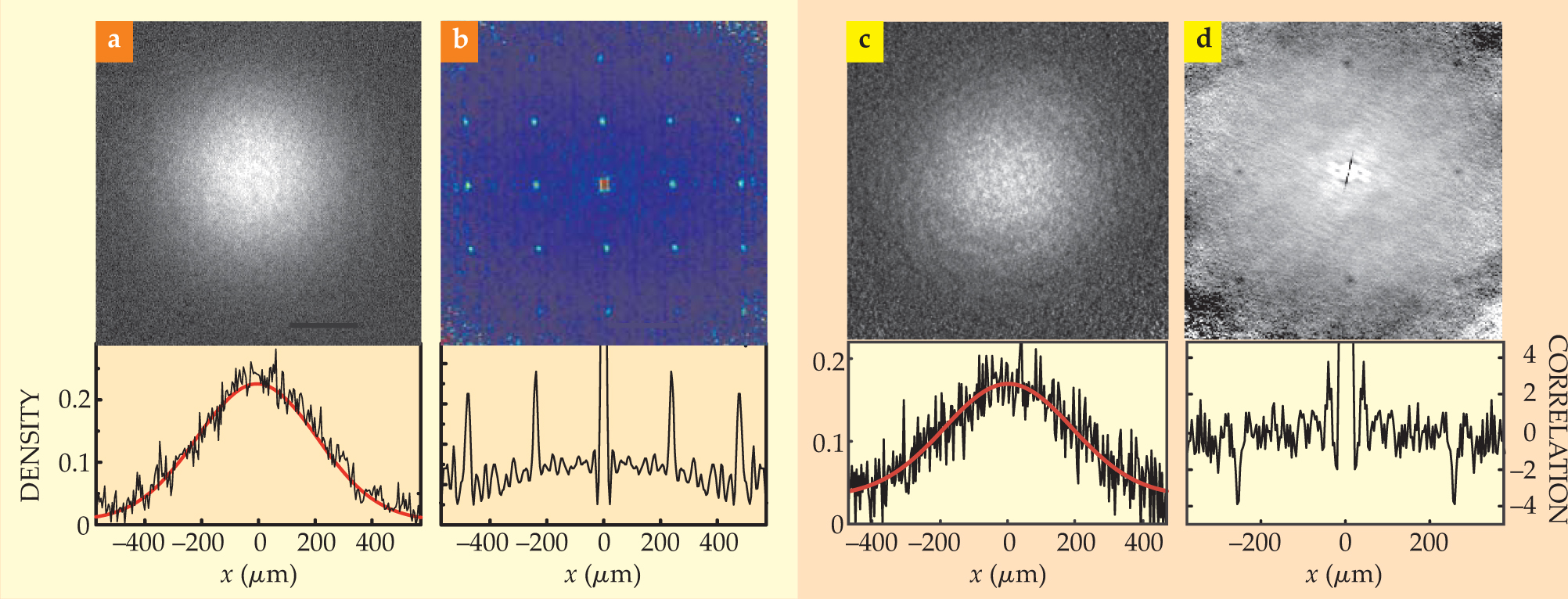Antibunching observed in cold, dense gases of fermionic atoms
DOI: 10.1063/1.2718744
In the late 1990s, physicists figured out how to adjust the interaction between atoms in cold, dense gases. Provided the atoms’ energy levels are favorable, a magnetic field suffices to tune the interaction from weak to strong or from repulsive to attractive.
With that tuning ability came the prospect of exploring few- and many-body phenomena over ranges of conditions far wider than available in a given crystal, liquid, or nucleus. Antiferromagnetism and high-T c superconductivity await their realization in cold atomic gases, but Cooper pairing, Efimov trimers, Mott insulators, and the Berezinskii-Kosterlitz-Thouless transition have already been observed.
Now, two independent groups have added another coherent phenomenon to the cold-atom repertoire: antibunching. Antibunching is the fermionic equivalent of bosonic bunching. Half a century ago, Robert Hanbury Brown and Richard Twiss sought and found bunching in photons from a mercury discharge lamp.
The two cold-atom groups used different techniques. Immanuel Bloch of Johannes Gutenberg University in Mainz, Germany, and his collaborators released potassium-40 atoms from an optical lattice; they observed antibunching in the shadow cast by the atoms on a CCD camera. 1 Wim Vassen of Amsterdam’s Free University, Christoph Westbrook of the Optics Institute in Orsay, France, and their collaborators released helium-3 atoms from a single-well trap; they observed antibunching in the pattern of atoms falling onto a microchannel plate. 2
Although fermionic antibunching has been observed before—in electrons, neutrons, and high-energy particles—the Mainz and Amsterdam–Orsay groups are the first to measure the length scale over which the effect’s coherence extends. In both experiments, the length is consistent with textbook theory.
Of more significance, the two experiments foreshadow the use of antibunching and bunching as diagnostic tools. Typically, one releases trapped atoms and images the shadow of the expanding cloud. The technique reveals density differences but not Cooper pairing and other phenomena that don’t affect density.
But buried in the noise of those same images lies an antibunching or bunching signal. Three years ago, Harvard University’s Ehud Altman, Eugene Demler, and Mikhail Lukin showed how to analyze correlations within the noise and extract the signature of coherent phenomena such as Cooper pairing and magnetic order. 3 If physicists succeed in creating a cold-atom analogue of a high-T c superconductor, now they have a way of probing it.
Seeing stars
The original Hanbury Brown and Twiss effect—bunching—appears when a light source is viewed by two nearby detectors. As shown in the inset in figure 1, photons from two source points S1 and S2 reach two detectors D1 and D2 in two ways: via the shorter blue paths and via the longer red paths. Because photons are indistinguishable, the paths interfere.

Figure 1. Bunching and antibunching occur when the paths taken by indistinguishable particles interfere on their way from source points S1 and S2 to detection points D1 and D2. As a result, the arrival of atoms at two locations (yellow patches) is correlated. In the Amsterdam–Orsay experiment, the freely expanding atoms land on a microchannel plate (dark disk), which records their positions and arrival times.
(Adapted from ref. 2.)

The interference is constructive for photons and other bosons. If you could hear photons arrive like light rain on a tin roof, the pitter-patter would sound oddly bunched up. For 40K atoms, 3He atoms, and other fermions, the interference is destructive. The fermions’ analogous pitter-patter would sound just as odd as the bosons’s, but in the opposite sense: The drops would avoid arriving together.
Particles emitted by lamps and atom clouds originate from more than two points. Bunching or antibunching occurs when, for all the source pairs, the phase difference between the crossed and uncrossed paths remains small. Widening the separation between the detectors smears the phase differences and dissolves the interference.
Hanbury Brown and Twiss’s experiment inspired the foundation of quantum optics, but the pair’s intent was to determine the angular sizes of main-sequence stars. They converted two World War II searchlights into light buckets, pointed them at Sirius, and correlated the two signals. By separating the detectors until the correlation vanished, they deduced the star’s diameter.
Cooling helium-3
Of the two new antibunching experiments, the Amsterdam–Orsay one comes closest to Hanbury Brown and Twiss’s original. Rather than take a shadow image of the cloud, the Amsterdam– Orsay group recorded the location and arrival time of the atoms as they fell under gravity and landed on a microchannel plate. Figure 1 shows the setup schematically.
Using an MCP has the advantage of providing a three-dimensional view of the cloud. Horizontal positions come from the MCP itself; vertical position is derived from arrival times. Correlations appear and can be analyzed in any of the three dimensions. But there’s a disadvantage: Slowly moving atoms lack the kinetic energy to trigger an electron avalanche in an MCP. Consequently, the atoms have to be in excited states. Of the atoms cooled to degeneracy so far, only helium has a convenient and long-lived metastable state.
Two years ago Westbrook and his collaborators used an MCP to observe bunching in a cold gas of 4He atoms, which are bosons. 4 Observing antibunching in fermions is more challenging because Pauli’s exclusion principle prevents cold fermions from exchanging energy when they collide. As a result, the standard technique for reaching the lowest temperatures—evaporative cooling—won’t work by itself.
To create a near-degenerate Fermi gas, cold-atom researchers apply evaporative cooling to a mixture of bosons and fermions. Drawing off the highest-energy atoms leaves the remainder to re-equilibrate through collisions and reach the same ultralow temperature. At that point, a burst of resonant RF radiation can be applied to spring the bosons, but not the fermions, from the trap.
Sympathetic cooling works for lithium-6 and lithium-7 and other fermion–boson mixtures, but it has proved hard to apply to 3He and 4He for a variety of technical reasons. Last year Vassen’s group succeeded in creating the first 3He degenerate Fermi gas. 5
When Vassen heard of Westbrook’s 4He bunching experiment, he proposed a collaboration. The Orsay team took its detector to Amsterdam. Within a few months, the Orsay and Amsterdam researchers had combined their respective instruments and seen their first antibunching signal. For a direct comparison with bunching, the experiment was repeated with 4He under the same trapping conditions. Figure 2 shows the results of the two runs.

Figure 2. Helium-3 atoms (red points) are antibunched on a time scale that corresponds to a vertical separation of about 1 mm. Helium-4 atoms (blue points) are bunched on the same scale. For each plot, 1000 clouds were trapped and released to attain a sufficient signal-to-noise ratio.
(Adapted from ref. 2.)

In principle, bunching or antibunching is total. If you monitored the contents of two nearby volume elements of phase space, you’d count twice as many bosons as you’d expect from random noise and no fermions. But as Figure 2 shows, the degree of bunching or antibunching detected is 10% at most. The shortfall arises from the detector, which gathers the signal from several volume elements simultaneously, blurring and therefore reducing the observable correlation.
Optical lattices
The Mainz group worked with 40K atoms, which can be sympathetically and readily cooled in the presence of rubidium-87. Once the 40K atoms had reached 2 µK, they were loaded into a 3D optical lattice whose individual wells were deepened to confine the atoms, one per well.
It’s possible to think of the Mainz experiment in terms of interfering paths, just as in the Amsterdam–Orsay and Hanbury Brown and Twiss experiments. But an equivalent, condensed-matter view reveals how antibunching carries information about the band structure of an optical lattice.
Like the most loosely bound electrons in a crystal, the trapped 40K atoms behave like plane waves whose amplitudes are modulated by the lattice period. An atom’s momentum state is a superposition of its crystal momentum ħq and the momentum 2nħk it acquires in an nth-order diffraction from a lattice of wavenumber k.
After release, the atoms travel for time t for a distance xn = (ħq + 2nħk)t/m, where m is the atoms’ mass. Atoms with identical crystal momentum ħq would end up in positions equally spaced by a distance L = 2ħkt/m. But fermions can’t occupy the same crystal momentum state. If an atom arrives at x, others won’t be found at x + L, x + 2L, and so on.
To detect this antibunching, the Mainz group used the standard technique of illuminating the released atoms with a resonant laser and recording the shadow on an optical CCD. Calculating the point-to-point correlation from the image yields the expected minima at integer multiples of L.
Doing so proved challenging. The image integrates the atoms’ positions along the laser’s line of sight. Regardless of how well the optics resolve the cloud, several phase-space volume elements are combined, damping the observed correlation.
By carefully removing sources of extraneous noise, the Mainz group saw antibunching at a low but significant factor of 10−3. Like the Amsterdam–Orsay group, the Mainz group had previously used their setup to observe bunching with bosonic atoms (87Rb). 6 Figure 3 shows results from both runs.

Figure 3. When released from an optical lattice, rubidium-87 atoms bunch, whereas potassium-40 atoms antibunch. Panels (a) and (c) show the density profiles of the 87Rb and 40K clouds, respectively. Cross-correlating the 87Rb density profile yields the bunching signal in (b). Cross-correlating the 40K density profile yields the antibunching signal in (d).
(87Rb images adapted from ref. 6; 40K images adapted from ref. 1.)

In 2005 Deborah Jin of NIST in Boulder, Colorado, and her collaborators trapped 40K atoms and tuned a magnetic field to coax the fermions into weakly bound molecular pairs. After releasing the molecules from the trap, they detuned the field to break up the molecules and imaged the expanding cloud. The newly unbound atoms separated from each other in opposite, correlated directions. Following Altman, Demler, and Lukin’s recipe, the NIST group found and measured those pair-wise correlations in the shot noise of the image. 7
It’s hoped that an optical lattice filled with fermionic atoms could mimic a high-T c superconductor. Conceivably, a NIST-like experiment in an optical lattice could reproduce and reveal the mysterious correlations that lead to the emergence of cuprate superconductivity.
In his autobiography, Hanbury Brown recalled with bemusement the theoretical controversies his and Twiss’s effect stirred up. One suspects he’d be pleased to see it find another experimental application.
References
1. T. Rom, T. Best, D. van Oosten, U. Schneider, S. Fölling, B. Paredes, I. Bloch, Nature 444, 733 (2006). https://doi.org/10.1038/nature05319
2. T. Jeltes, J. M. McNamara, W. Hogervorst, W. Vassen, V. Krachmalnicoff, M. Schellekens, A. Perrin, H. Chang, D. Boiron, A. Aspect, C. I. Westbrook, Nature 445, 402 (2007). https://doi.org/10.1038/nature05513
3. E. Altman, E. Demler, M. D. Lukin, Phys. Rev. A 70, 013603 (2004). https://doi.org/10.1103/PhysRevA.70.013603
4. M. Schellekens, R. Hoppeler, A. Perrin, J. Viana Gomes, D. Boiron, A. Aspect, C. I. Westbrook, Science 310, 648 (2005). https://doi.org/10.1126/science.1118024
5. J. M. McNamara, T. Jeltes, A. S. Tychkov, W. Hogervorst, W. Vassen, Phys. Rev. Lett. 97, 080404 (2006). https://doi.org/10.1103/PhysRevLett.97.080404
6. S. Fölling, F. Gerbier, A. Widera, O. Mandel, T. Gericke, I. Bloch, Nature 434, 481 (2005).
7. M. Greiner, C. A. Regal, J. T. Stewart, D. S. Jin, Phys. Rev. Lett. 94, 110401 (2005). https://doi.org/10.1103/PhysRevLett.94.110401




